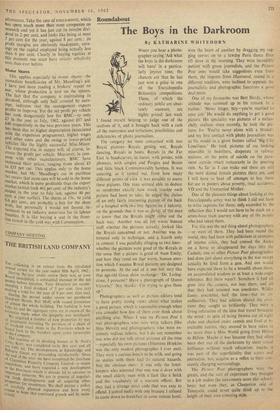Roundabout
The Boys in the Darkroom
By KATHARINE WHITEHORN
The category we were concerned with was Royal pictures—Royals getting wet, Royals dancing, Royals in boats, Royals in the Far East in headscarves, in tiaras; with ponies, with phoneys, with corgies and Porgies and Bcsses and little black Commonwealth Sambos. It was amazing, as it turned out, from how many different points of view it was possible to assess these pictures. One man seemed able to deduce or remthriber exactly how much trouble each picture had been to take; he urged the claims of an only fairly interesting picture. of the back :of a hospital with, two tiny figures on a balcony, on the grounds that it was so clever- of the man to know that the Royals might chine out the back way. Another was all for warm human stuff whether the pictures actually looked like the Royals concerned or not. Another was in- terested only in technique, and a fourth only in content. I was painfully clinging to two lines: whether the pictures were good of the Royals in the sense that a picture is good of Aunt Emily; and how they rated on that warm, human emo- tion which I assume Royal pictures are designed to promote. At the end of it one felt very like that age-old Goon show exchange: 'Dr. Living- stone, I presume? Have a photograph of Queen Victoria!"No, thanks --I'm trying to give them up.'
Photographers as well as picture editors tend to have pretty strong views about what makes a good picture, which is reasonable enough when you consider how few of them ever think about
anything else. When I was on Picture Post I
met photographers who were witty talkers (like Slim Hewitt) and photographers who were ex-
tremely tedious talkers; but I do not remember
one who did not talk about pictures all the time --especially his own pictures (Thurston Hopkins was the only modest photographer I ever met).
They were a curious bunch to be with, and going on stories with them had its natural hazards.
Not the obvious ones: it was only the hotel- keepers who assumed that one was a deux with the small elderly man with a face like a brick
and the vocabulary of a warrant officer. But they had a strange strict code that was easy to offend. I scored badly with one because I refused to come down to breakfast in some remote hotel, won the heart of another by dragging my sag- ging nerves on to a tawdry Paris dance floor till three in the morning. They were incredibly patient with green journalists, and the Picture Post ones would take suggestions even from them; the imports from Illustrated, reared in a different tradition, were inclined to separate the journalistic and photographic functions a good deal more.
One of my favourites was Bert Hardy, whose attitude was summed up in his remark to a trainee: 'Never forget, boy—you're married to your job.' He would do anything to get a good picture. His speciality was pictures of a melan- choly realism—even recently, he took the pic- tures for 'You're never alone with a Strand': and my first contact with photo journalism was as his model in a glum feature called 'Big City Loneliness.' He took pictures of me looking miserable in bedsitters, desperate in railway stations, on the point of suicide on the pave- ment outside smart restaurants in the pouring rain. As far as I can make out these are still the most dismal female pictures there are, and I still have to beat off attempts to buy them for use in posters about poverty, road accidents. VD and the Unmarried Mother.
One of the pleasant things about looking at the Encyclopaedia array was to think I did not have to write captions for them; only exceeded by the reflection that I would not have to be stuck on a seven-hour train journey with any of the people who had taken them.
For this was the sad thing about photographers —or most of them. They had been round the world, they had been with politicians at moments of intense crisis, they had crossed the Andes on a horse or disappeared for days into the Casbah; one or other Picture Post photographer had done just about everything in the war except actually be fired from a gun. And one would have expected there to be a breadth about them, an accumulated wisdom or at least a wide-angle
tolerance. But there wasn't. Somehow it had all gone into the camera, not into them, and all that they had retained was anecdotes. Wildly
funny anecdotes, half the time—but no co- ordination. They had seldom shared the emo- tions they caught so brilliantly. They were a living refutation of the idea that travel broadens the mind: in spite of being thrown out of night
clubs and chained under camels and fired at by excitable natives, they seemed to have taken in no more than a Miss World going from Hilton to Hilton. Maybe it was because they had often
been shot out of the darkroom by sheer visual brilliance without much education; may be it was part of the superficiality that actors and journalists, too, acquire as a reflex to their con- stantly changing surroundings.
The Picture Post photographers were the greats, and the sort of experience they brought
to a lob makes the newcomers seem like school- boys; but even they, as Chesterton said of Tennyson, could never quite think up to the height of their own towering style.






































 Previous page
Previous page